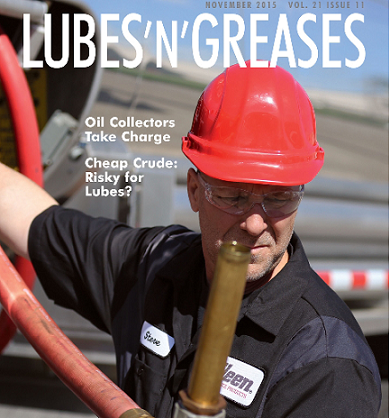Safety Kleen Canada
Charge!
Used Oil Market Swings to Pay-to-Collect

LUBES'n'GREASES, November 2015, VOL. 21 ISSUE 11
Rerefining’s about-face from paying generators for their used oil is gaining momentum, reinforced by one of the biggest names in the industry. Safety-Kleen’s parent company announced in late August it would begin charging to gather used oil from all non-contract generators and will expand its application of a service-call surcharge.
“The recent decline in crude oil pricing, along with associated decreases in fuel and base oil pricing, have materially affected the values of our recycled fuel oil and rerefined products,” Safety-Kleen President Jerry Correll said in a news release.
“Given the impact of these falling prices, we are now charging disposal rates in order to mitigate the market-derived pressure on our margins and further deterioration in the existing spread.”
Safety-Kleen is a unit of Norwell, Mass.-based Clean Harbors. Last year, Clean Harbors posted revenues of $3.4 billion, of which $533.6 million came from used oil rerefining and recycling.
Safety-Kleen is implementing its charge-for-oil program in both the United States and Canada, where its three rerefineries have a combined capacity of 8,050 barrels per day of API Group I and II base oils. In addition, the company will significantly expand its service-stop fee program — a fixed fee charged for visits to collect smaller amounts of used oil in lieu of its normal per-gallon rate — to help recoup transportation and labor costs associated with more remote locations.
Crude’s Impact
Other companies involved in both used oil collection and rerefining agreed the market is transitioning away from pay-for-oil towards a zero-pay or charge-for-oil system. All agreed that the sharp decline in petroleum prices, along with its ripple effects, is the key factor.
“It’s more the crude markets, and it is the result of this imbalance of supply and demand that has pushed down pricing on just about all the products, from base lube to refinery fuels,” Correll told Lubes'n'Greases.
Greg Ray, chief operating officer of Heritage-Crystal Clean, noted that over the past 12 months, the price of Brent erode oil has fallen from $105 per barrel to under $45 per barrel — a decline of $60 per barrel, or $1.43 per gallon. “During that same period, the price paid by used oil collectors has fallen by around 80 cents/gallon,” Ray told Lubes’n'Greases in late August. “Since the value most used oil collectors get for their used oil — or the products that they produce — tracks crude oil, it is easy to see why margins have shrunk dramatically. Because the used oil business was not very profitable before this occurred, we believe that ultimatelv the reduced value of oil products will translate into lower prices for generators, and ‘pay for oil’ will shift back to ‘charge for oil.’”
Heritage-Crystal Clean posted $339 million in revenue hist year; its rerefinerv in Indianapolis can make 2,500 b/d of Group II base oil.
Ray noted that charge-for-oil needn’t be a net financial loss for used oil generators. “Many of the accounts that generate used oil, like car dealerships and quick lubes, are also purchasing new lubricants in their business, and the cost of these products has come down at least as much as the value of the used oil they generate," Ray said.
He emphasized that crude prices are the biggest reason that used oil values are much lower than a year ago. “Used oil is purchased as feedstock for rerefineries that produce base lube oil; it is purchased as feedstock for processing plants that produce [vacuum gas oil); and it is purchased as blending stock in certain liquid fuels,” Ray said. “In each of these applications, the finished products are sold for prices that correlate with crude oil prices.”
Driving Forces
Prices for all of these products have fallen sharply, and they are not expected to rebound soon, said Vertex Energy CEO Ben Cowart. “The market view now is that low oil prices will remain low for a while,” he said. Columbus, Ohio-based Vertex, which had 2014 revenues of $259 million, processes 135 million gallons of used motor oil a year — about 10 percent of what the country generates, it estimates. It also has acquired two rerefineries (Heartland in Ohio, and Bango in Nevada) with combined capacity of 2,900 b/d of Group II base oil.
Other factors also come into play, Cowart pointed out, as demand has been slowing for crude oil and products alike. “This lack of demand has had an additional negative impact on values,” Cowart told Lubes 'n'Greases. “Cheap natural gas has continued to keep pressure on the value of used motor oil, as half of the country’s used oil is still simply burned as a raw fuel for its [British thermal unit] value.” Ray concurred, adding that the substantial decline in natural gas prices has allowed many fuel-burning firms like asphalt plants and steel mills to shift away from used oil to natural gas to save money. “This has reduced the size of used oil markets and the value of the used oil,” he said. "Also, while fuels are still the primary outlet, about 40 percent of collected used oil is going to rerefining today, and to the extent that the lube-to-crude spread is tighter than a few years ago, rerefining margins are impacted, which in turn diminishes the value of used oil feedstock that is used for rerefining.”
Safety-Kleen’s Correll said that back in December 2014, while the industry saw reductions in base oil pricing, prices for products such as refinery fuels, asphalt extenders and recycled fuel oil were all holding up pretty well.
“Now, we’re seeing some pretty significant reductions in pricing on all those products,” he said. “So when we take those into consideration along with the reduction in the base lube [pricing], you can see how that can depress our spreads and affect our margins.
“There’s not much we can do about the pricing out there. The only way we can really manage our business is through management of our costs.”
Although crude’s decline certainly contributed, Jim Scott, vice president of supply chain for Avista Oil USA, said the rules of supply and demand were the largest driving factor. “The markets’ oversupply on both raw materials and finished goods, accompanied by falling crude prices, really created the perfect storm,” Scott noted. “Due to this phenomenon, as an industry we have witnessed consolidation. In fact nationwide, many collectors simply have gone out of business due to the inability to respond to these changes.” Germany-headquartered Avista can process 35 million gallons of used oil per year at its Peachtree City, Ga. plant, which has 1,250 b/d of Group II capacity.
 |
 |
 |
Safety-Cleen's Jerry Correll Ben Cowart of Vertex Energy Greg Ray of Heritage-Crystal Clean
A Fresh Mindset
While the financial advantages seem obvious, Scott explained that charging to collect waste lubricants is not easy. “Several variables weigh into this decision, which is not taken lightly by the collection community,” he told Lubes'n'Greases. “The transition from a pay market to a charge market is a difficult adjustment not only in mindset, but operating procedure as well.”
This transition is difficult for generators of used oil to understand and accept, he conceded. “Although the markets’ deterioration has been ongoing for nearly a year, conceptually the charge for responsible handling of the material is one most generators hadn’t envisioned, despite the many warning signs,” Scott said.
Ray said competition among collectors for used oil volumes remains high, and that this makes some cautious about charging for oil.
"These collectors are nervous that if they are the first to charge for used oil collection, their customers will shop around and find someone else who is still picking up used oil for free, or even paying a little for used oil, and they will lose important accounts and market share,” he explained. “From the customer’s perspective, the difference between being paid a few pennies a gallon, or charged a few pennies, can seem like a big deal, even though in real dollar terms it is insignificant. For example, for a typical used oil generator who has 1,000 gallons of used oil annually to be collected, a five-cent swing in their price only represents $50 per year. But the perception that they are now paying for a service instead of being paid for the oil causes some customers to hesitate.”
Those with sufficient storage capacity can choose to hold on to their used oil in the hope that prices will recover, Ray pointed out, which places more pressure on collectors as they see their volumes drop off.
Shifting from pay-for-oil to charge-for-oil demands some administrative dexterity on the part of collectors, too. “It is more complex to bill a customer and then manage accounts receivable than it was to just hand out cash for oil,” Ray said. “Some companies that have not done this before (or that have not done this in a long time) may need to adjust their systems before they can accomplish this transition.”
Vertex's Cowart said the biggest challenge in moving towards a chatge-for-service business model is that mindsets have to shift all the way up the used oil supply chain, to motorists paying for oil changes. “After the industry covers its col-lection cost, there is a shortfall that has to be passed down to the generator and on to the consumer,” Cowart told Lubes'n’Greases. “Moving the spread back to the consumer seems to be the biggest challenge that is out of our control.”
Hitting Reset
Rerefiners said this would not be the first time collectors charged to take away used oil.
“I ran the largest used oil collection business in North America from 1994 to 1999, and we were typically charging around 20 cents per gallon to pick up used oil,” said Heritage’s Ray, who was with Safety-Kleen earlier in his career. “This was the norm for the industry at the time, when crude oil prices were low. On an inflation-adjusted basis, that 20 cents per gallon then is more like 30 cents per gallon today. Looking further back, the industry was charging to pick up used oil in the late 1980s, when crude oil prices fell after the conclusion of the Iran-lraq war.”
Safety-Kleen’s Correll recalled the later shift to pay-for-oil: “As it turned into the early 2000s, and as oil values began to pick up, there was a gradual move to pay-for-oil. That continued to exist through the last year or so.”
He said that Safety-Kleen had sometimes charged customers for oil collection if they were long distances from its rerefineries. “That practice wasn’t prevalent across the majority of the business,” he added.
Vertex's Cowart said that over his 29 years in the industry, charging for used oil collection has happened several times. “What is interesting today is where the charge threshold is related to crude oil prices,” he said. “The industry is much differ-ent today than the last time this happened. The regulatory and compliance cost to truly protect the generator from the cradle-to-grave liabilities are real, not to mention the professional staff needed and the cost of today’s rolling stock.”
Source: http://www.safety-kleen.com/about-us/news/lubes-n-greases-used-oil-market-swings-to-pay-to-collect
General Laborer
You will be responsible for providing support on all of our projects. This could include performing basic labor tasks as well as assistance with the operations of high pressure water pumps, high pressure units and vacuum trucks as well.
Class 3 Operators
You will be responsible for operating and driving the assigned unit and for performing a variety of jobs as dictated by the client.
Account Manager- Environmental Services
The Account Manager is responsible for growing new accounts and expand and/or maintain existing accounts for the assigned specified book of business.